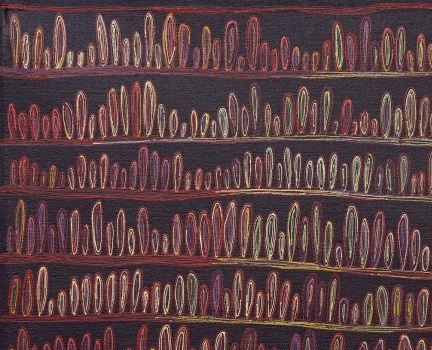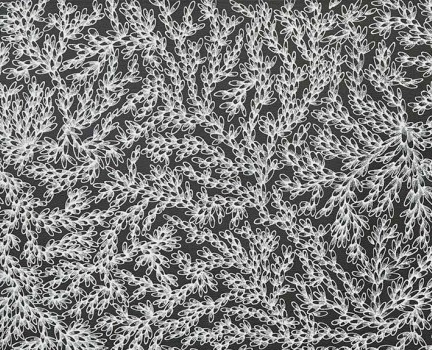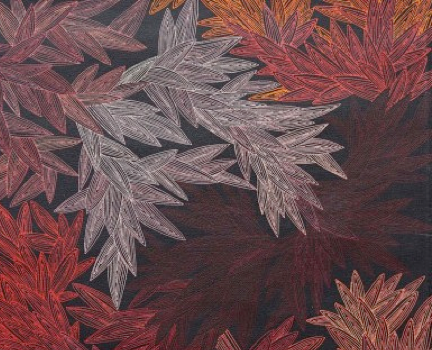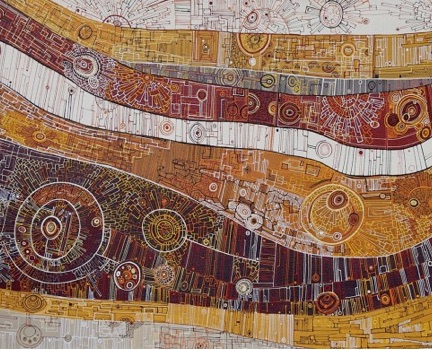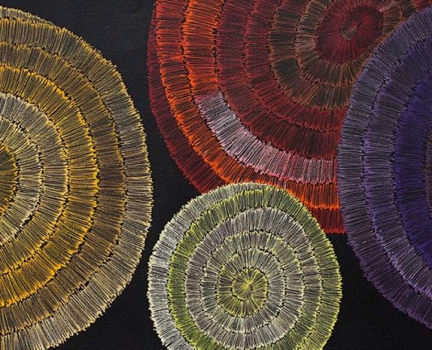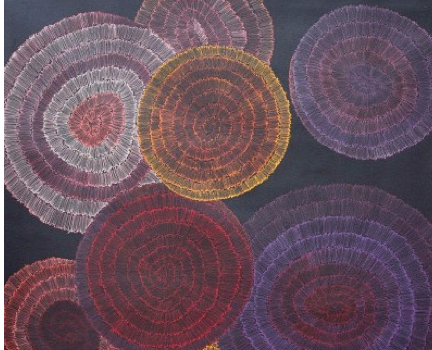Kerry McCarthy: Grandfather’s Song & The Janet Holmes à Court Collection
Kerry Madawyn McCarthy is an Aboriginal artist from Daly River in the Northern Territory. On the eve of her second solo exhibition at Japingka, she talks here about the influence of her grandfather and what painting means to her.
You’ve had some good news?
Yes. I've been told by Ian and David that my feature piece for this exhibition, my Grandfather's Song, has been bought by the Janet Holmes à Court Collection. I never thought that any of my pieces would go into what I think is such a prestigious art collection. I'm pretty proud of myself. That particular piece is about my grandfather - he played a great big role in my life.
It's pretty special that that's the painting that sold first.
It is and the actual Grandfather's song painting is about when I was little and growing up. I remember watching my grandfather just tap these really thick set nails either on the table or on the side of the chair. I’d just be listening to him sing and just watching him go through the motions. He'd either be singing in language or he'd be humming but he would be tapping and tapping away. Sometimes he'd be tapping fast, sometimes he'd be tapping slow.
As I painted I was thinking about where he would have been and how he would have lived his life. I was thinking of his reminiscing about all those years ago. I’d be thinking about my grandmother, the time he spent with her and raising all my mum's and my uncles all around the coast, in the bush. To me, he was just such an awesome man and he still is an awesome man. He's one of the biggest reasons why I paint today.
Can you remember when you started painting?
If you want to go right back, when we were little, I was about six or seven years old when I first painted. My Dad used to pull out these big bits of butcher paper and he'd get these big bottles of paint. Every Sunday, he would get all us kids out and sit out on the back veranda. We would just paint to our heart's content. If you're talking about my earliest memories of painting, that would be it.
My professional painting started about 1994. At first, I started painting more of a tourist kind of art about bush tucker, animals, all those types of things. Leaps and bounds and years and years later, I'm doing so many other different things and exploring so many different techniques and trying to create texture. I’m just trying to get a whole different feel for what I can do. I’m learning how using different things like a Gutta bottle or different types of brushes can change what I'm doing. I love just being able to create new things, different things. I guess for myself, creating new things is something that I'm just so happy doing. I guess, when I’m creating and creating new stuff, I'm a duck in water.
Who have been the major influences over you as an artist?
I'm self-taught. At first, I loved drawing. I would draw just about anything and everything. I drew a lot by myself before I started painting.
When I started painting I moved to Bachelor. Two of my mums, my mum Maggy (Agatha Ngakmik Morgan) and my mum Rose (Rosemary Parrabaty Morgan), they suggested why don't you go to the Batchelor Institute (Batchelor Institute of Indigenous Tertiary Education). So I ended up enquiring, it’s a year-long certificate course in art and craft.
I enrolled and the next thing I knew I had learned a lot of different aspects of art, from painting onto silks, canvas and paper, printing on paper and 10-metre rolls of material, to ceramics and sculpture. It was a great big eye opener and gave me a chance to explore different aspects of art.
I’ve been able to learn all those different things and apply them to what I'm doing. Going to the Bachelor Institute has helped me to learn a lot.
What would you like to see come out of your developing work as an artist? Where are you heading?
I would love to be able to continue creating new stuff. I don't like the idea of sitting stagnant. For about four years I sat painting the same design, and I got so sick of it I didn't want to do it anymore. So I guess where I want to go and what I want to do is to be able to keep on either refreshing what I'm doing or continue to move forward in some way or another.
It may be that it's continuing to take more photos. I love taking photos. I take photos like crazy and whether it's of rocks or seeds or bark or trees. I just love doing different things like that. I love drawing and I continue to draw and draw and draw. It might sound repetitive but I like the idea of being able to move my old stuff into new and try to kind of refresh it or put it on another course so to speak.
What are the most satisfying aspects about painting your stories?
I love painting, I don't see it as a job. This is my passion, something that I love doing, and I don't want to do anything else.
My stories are not only my stories, they are stories about my grandfather. There are stories about going out on land and on country. Because of the impact that my grandfather has had on my life, I feel like it is so important that I not only tell my parts of them but I also tell his parts of them. He was just such a great man, he's an awesome man. He's humble, but then you know, he was head-strong, he didn't beat around the bush or anything like that. He was just such a good man and that's just something that I want to be able to get out there and tell the world about.
If people will listen and if people love the paintings and buy the paintings that's another bonus for me. For myself, it's all about my grandfather and everything that he stood for. I love being able to share with the world who he was and how great of a man he is and how much I know how great of a man he is - that’s the most important part for me.
That's one of the satisfying parts?
Yes, that is. I don't even think when it comes to it, it's not even about the money. When I found out that that painting went to the Holmes a Court collection, I was in tears. I kept balling my eyes out.
What is it like to see your work up in an exhibition like this in Japingka?
It has been months and months and months of preparing and painting, getting all these different styles and techniques onto linen. Now I’m seeing them all in the same room.
When I first walked in I was kind of speechless. I'm just seeing all of the pieces that I've worked on at some stage or another and feeling how much they mean to me. It takes the words out of my mouth. I've really, really, really enjoyed painting them.
Where would you like to see your exhibitions go in the future?
If there are other galleries out there that would love to be able to exhibit my works, I would love to take on that type of opportunity. I think, for myself as an artist, it's being able to get my works out there and showing the world who Kerry Madawyn McCarthy is. I feel as if, for myself, it's that part of me that's growing and it's out there. A lot of people will get a chance to be able to see it.
You've got some work in black and white and some in colour, is there a story behind this? Is there a difference?
When I first started painting, I felt that some of the stories deserved to be told in black and white rather than in colour. In the back of my mind, I just kept that option or the idea open. If there's something that I've wanted to paint, being able to paint it in black and white is, I guess, the better way to go. This is because it's being able to get that idea out and putting it onto linen and saying okay, does this work? Working like that gives me a chance to look at it and say okay, well you know, if it works, why not try it in colour.
In the case of paintings like Spitfire and Kapuk, which is Burning Rag I think they need to be painted in colour because the colour just helps it to be vibrant and it kind of brings it to life. I think stories like that need to be told with colour whereas other stories like Medicine Leaf can be painted in both black and white and colour. Other pieces like, After the Burnoff, I feel like, for the time being, just need to be told white on black. I think when it comes to using black and white or colour, I love using both. It just gives me a chance to be able to paint a lot more abstractly with colour. My sister Helen, who is also an artist, was the one who actually got me started on the abstract works. I've actually got one of those in this exhibition, which is the Burning Rag. When I first started the piece, she said to me okay, you've got to loosen up, don't think, you've just got to paint.
Apparently, I wasn't as loose, I was still painting with structure and she painted over it with black and then she said paint it again. After painting it again, obviously I got upset but it has taught me a great lesson in being able to paint so much more freely versus painting with structure. A structure is something that I've just been so used to and it was something that I did find really, really hard to break away from. With her help, it has happened. I'm proud to say I actually love abstract painting now. It just gives me a chance to be able to free that clutter up in the brain and be a lot more open and be a lot freer with what I'm doing.
Is that a career goal for you?
Yes, definitely, definitely. Painting and being able to create works like these. It has just really, really opened my eyes up to what I can do. I’m so happy having art as my passion and thank you universe or God or whoever it is out there but I'm glad. I'm just grateful that I've got something that I love doing. I get to show the rest of the world. I get to show people what I can really do and I just love doing it.
You were saying that the other day a friend asked you, why do Aboriginal people paint?
My friend asked me why do you paint your Grandfather's Song? It is because he has had such a profound influence on my life. Why did I paint his song and what does song mean to an indigenous person, an Aboriginal person? My grandfather, he sang songs because years back they didn't have any paper and pen to record all of these different stories.
It wasn’t the same as white men. They could compose their music and all of that but indigenous people use song to record their stories and you're talking about not only the stories. For instance, Burning Rag is a ceremonial and Burning Rag is a particular song which they sing through that ceremony. The songs in the Burning Rag Ceremony are a record of what happens in that ceremony and what it's about. You've got another ceremony called a Welcoming Ceremony and that's basically welcoming other tribes onto your land. In that ceremony, you've also got to sing songs as well.
Songs in Aboriginal culture are a record of a person’s everyday life, they are a record of all the ceremonies that they attend. Paintings are a record of all the different things - there are Birthing Ceremonies and then there are Burning Rag ceremonies. They're all records of your life - songs are life songs. When you think about it, you look into white society, they sing songs about so many different things and in different genres. When you think about songs and their meanings, that's what songs and paintings are. They’re a record of a ceremony, a record of your life as an indigenous person.
Read more:


